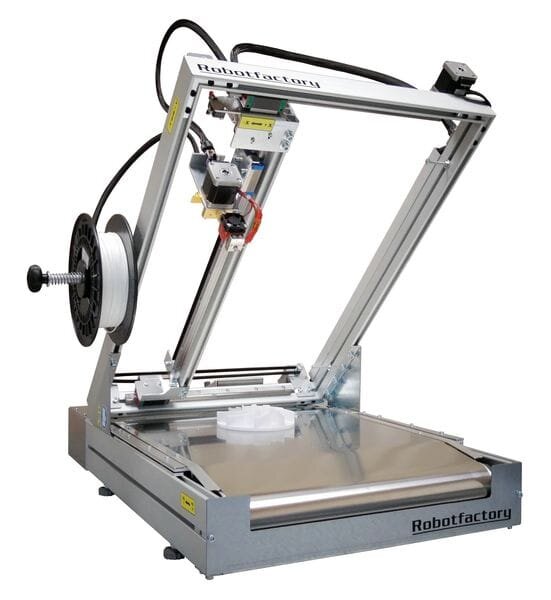![The Silver Belt 3D printer [Source: Robot Factory]](https://fabbaloo.com/wp-content/uploads/2020/05/Silver-Belt_img_5eb08d350b048.jpg)
Robot Factory has developed a new non-orthogonal 3D printer, the Silver Belt.
The Italy-based company has plenty of experience developing manufacturing devices, having produced several CNC-style machines since their founding in 2001. Recently, they’ve been exploring the 3D printer market and earlier this year we featured their unusual device, the Sliding-3D Plus “infinite” 3D printer.
3D Printing at an Angle
This device is quite strange in that its motion system is unlike the typical X-Y-Z cartesian or delta system 3D printers most frequently seen. Instead it tips the Z-axis over and 3D prints at an angle of 45 degrees.
Why the angle? It allows the machine to print on a moving conveyor belt. The best way to envision this process is to take a loaf of sliced bread, with each piece representing a 3D print layer. Place the bread on a table, and then tip all the slices at 45 degrees. That’s how the Sliding 3D printer operates: each slice is raised 45 degrees from the horizontal.
![Hot end of the Silver Belt 3D printer; note the 45 degree angle [Source: Robot Factory]](https://fabbaloo.com/wp-content/uploads/2020/05/image-asset_img_5eb08d354d2f9.jpg)
This provides a number of interesting benefits. First, because the slices appear at different positions, the bed must move along, layer by layer. This is the reason for the conveyor belt. But when you have a conveyor belt, it is trivial to remove completed 3D prints: just run the belt so that the print falls off the end as the belt turns around.
This feature allows for two powerful capabilities:
An object can theoretically be of infinite length, as it just “keeps going” as long as you have input material to extrude. In practical terms, you’d have to make arrangements for some method of catching and holding stable the extrusion as it lengthens.
![Electronics package inside the Silver Belt 3D printer [Source: Robot Factory]](https://fabbaloo.com/wp-content/uploads/2020/05/image-asset_img_5eb08d359556d.jpg)
The second capability is for continuous production. Imagine 3D printing smaller pieces, but many of them. As they are 3D printed, they simply fall off the conveyor belt into a catch-bucket. Again, this can continue as long as you have input material. This transforms the 3D printer into a kind of small manufacturing device that can be left alone to produce larger quantities of objects without much need for human intervention.
Powerful, indeed!
Stainless Steel 3D Printer Belt
Now Robot Factory announced the “Silver Belt” 3D printer, and I should note that it is actually provided in kit form. You will have to assemble this 3D printer, but from the description it does not sound particularly challenging to do so.
Why call it “Silver”? That has to do with the new device’s conveyor belt, which is now made from stainless steel. It’s quite shiny, so it appears to be silver.
There’s an important reason for Robot Factory to include this feature: heat. The idea is to enable the device to handle high-temperature materials. A new “PLUS” version of the Silver Belt 3D printer will be able to handle materials extruded at a very high 450C. In fact, the machine is said to be “all metal”, meaning there won’t be any plastic components that can soften if exposed to such high heat.
This opens up the possibility of continuous 3D printing of high-temperature materials like PEEK, PEKK, ULTEM and others, which I do not believe exists in any other high-temperature 3D printer. All other options require operator intervention to extract completed prints and set up for the next print job.
Silver Belt Enclosure?
I do have one question for Robot Factory about their high-temperature PLUS model, and that is how the ambient air temperature is handled. Normally high-temperature 3D printers always include a sealed enclosure to capture heat and reduce the temperature gradient between the print and its surroundings. However, the initial images of the Silver Belt device do not appear to involve an enclosure. I suspect that the PLUS version will include an enclosure for this very reason.
The Silver Belt 3D printer will be shown at Formnext, and we’re certain to drop by to see it and find out the answers to these questions. Robot Factory says the kit will be distributed commencing towards the end of the month.
Via Robot Factory

